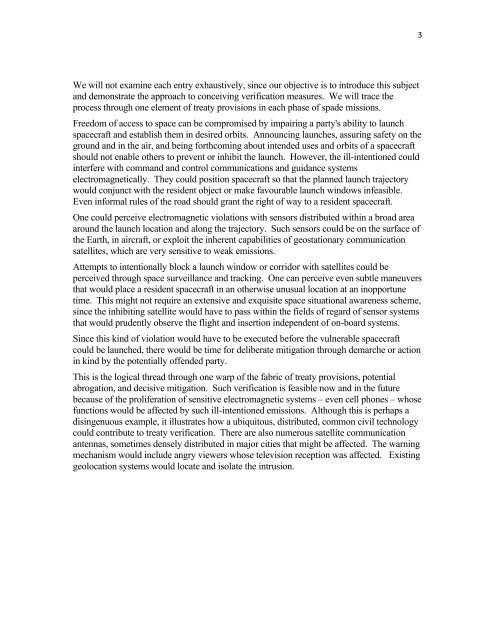Space and Verification
Space and Verification
Space and Verification
You also want an ePaper? Increase the reach of your titles
YUMPU automatically turns print PDFs into web optimized ePapers that Google loves.
We will not examine each entry exhaustively, since our objective is to introduce this subject<br />
<strong>and</strong> demonstrate the approach to conceiving verification measures. We will trace the<br />
process through one element of treaty provisions in each phase of spade missions.<br />
Freedom of access to space can be compromised by impairing a party's ability to launch<br />
spacecraft <strong>and</strong> establish them in desired orbits. Announcing launches, assuring safety on the<br />
ground <strong>and</strong> in the air, <strong>and</strong> being forthcoming about intended uses <strong>and</strong> orbits of a spacecraft<br />
should not enable others to prevent or inhibit the launch. However, the ill-intentioned could<br />
interfere with comm<strong>and</strong> <strong>and</strong> control communications <strong>and</strong> guidance systems<br />
electromagnetically. They could position spacecraft so that the planned launch trajectory<br />
would conjunct with the resident object or make favourable launch windows infeasible.<br />
Even informal rules of the road should grant the right of way to a resident spacecraft.<br />
One could perceive electromagnetic violations with sensors distributed within a broad area<br />
around the launch location <strong>and</strong> along the trajectory. Such sensors could be on the surface of<br />
the Earth, in aircraft, or exploit the inherent capabilities of geostationary communication<br />
satellites, which are very sensitive to weak emissions.<br />
Attempts to intentionally block a launch window or corridor with satellites could be<br />
perceived through space surveillance <strong>and</strong> tracking. One can perceive even subtle maneuvers<br />
that would place a resident spacecraft in an otherwise unusual location at an inopportune<br />
time. This might not require an extensive <strong>and</strong> exquisite space situational awareness scheme,<br />
since the inhibiting satellite would have to pass within the fields of regard of sensor systems<br />
that would prudently observe the flight <strong>and</strong> insertion independent of on-board systems.<br />
Since this kind of violation would have to be executed before the vulnerable spacecraft<br />
could be launched, there would be time for deliberate mitigation through demarche or action<br />
in kind by the potentially offended party.<br />
This is the logical thread through one warp of the fabric of treaty provisions, potential<br />
abrogation, <strong>and</strong> decisive mitigation. Such verification is feasible now <strong>and</strong> in the future<br />
because of the proliferation of sensitive electromagnetic systems – even cell phones – whose<br />
functions would be affected by such ill-intentioned emissions. Although this is perhaps a<br />
disingenuous example, it illustrates how a ubiquitous, distributed, common civil technology<br />
could contribute to treaty verification. There are also numerous satellite communication<br />
antennas, sometimes densely distributed in major cities that might be affected. The warning<br />
mechanism would include angry viewers whose television reception was affected. Existing<br />
geolocation systems would locate <strong>and</strong> isolate the intrusion.<br />
3
















